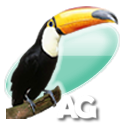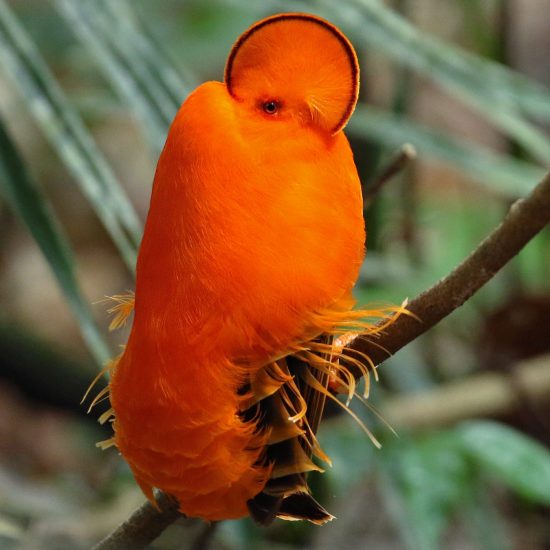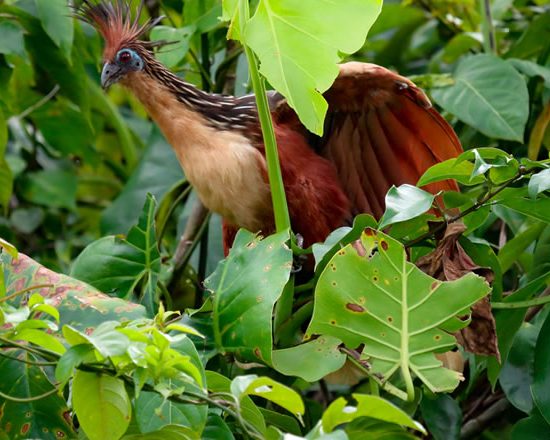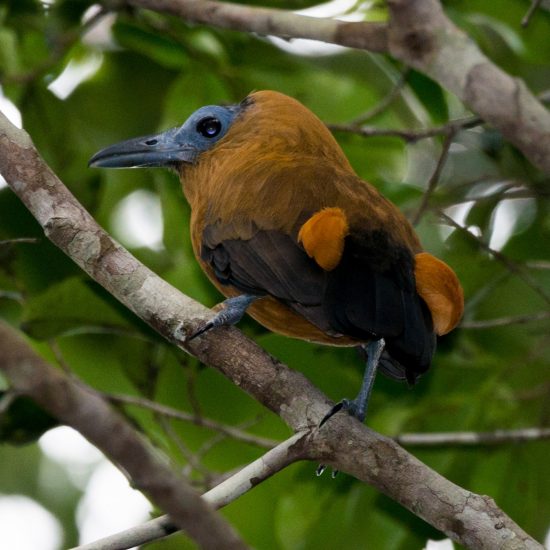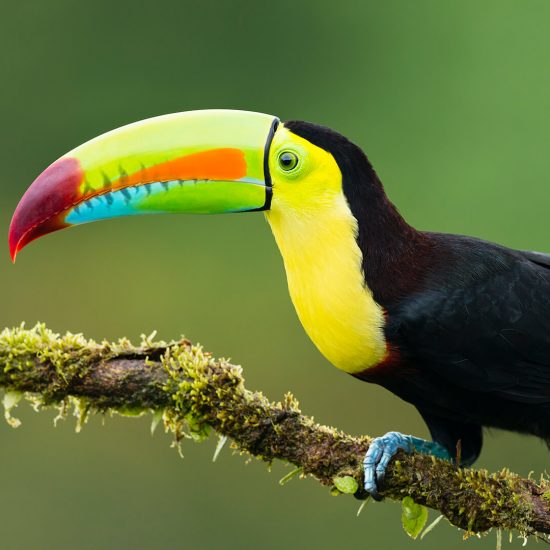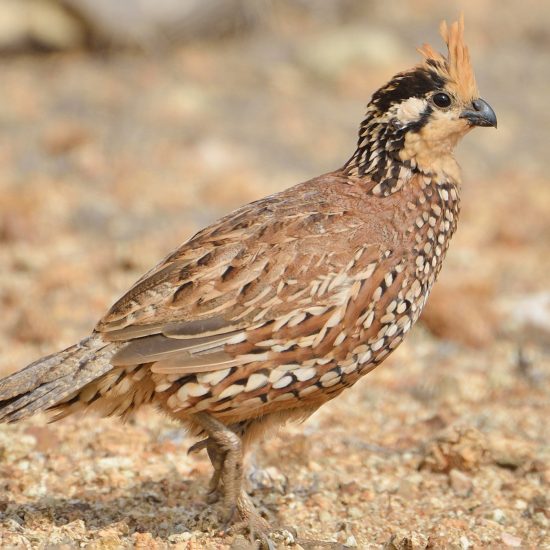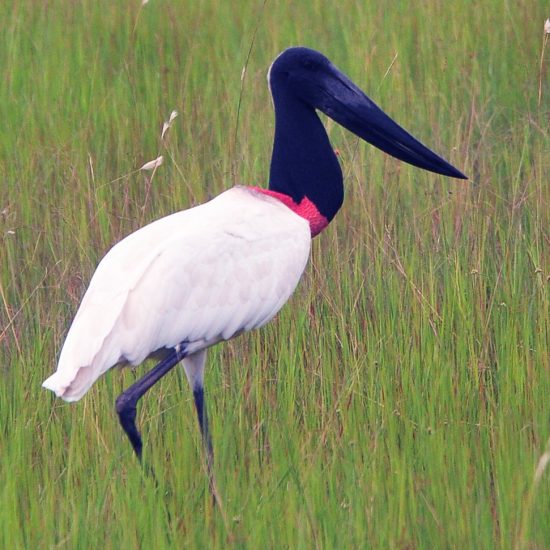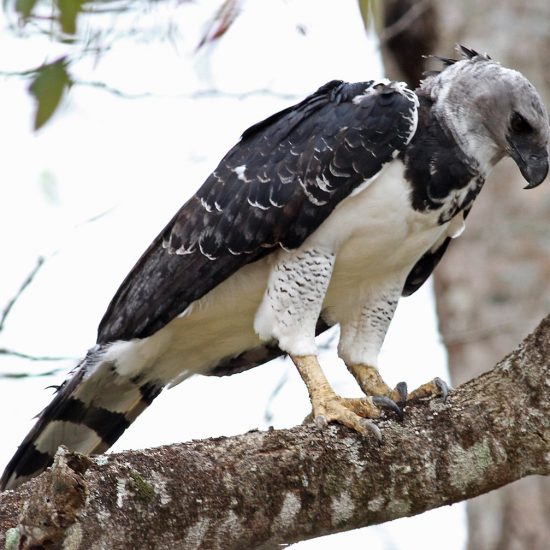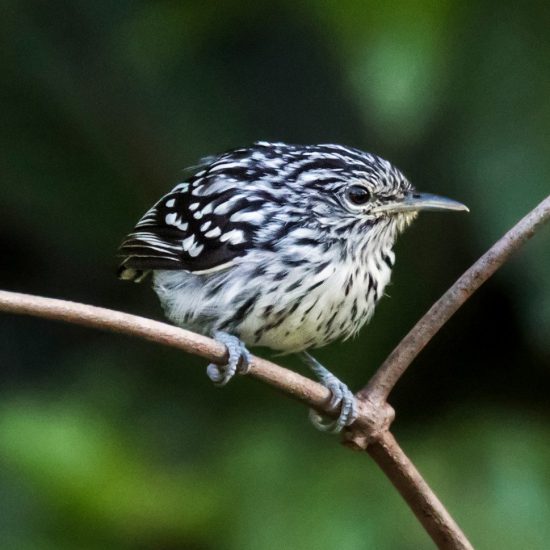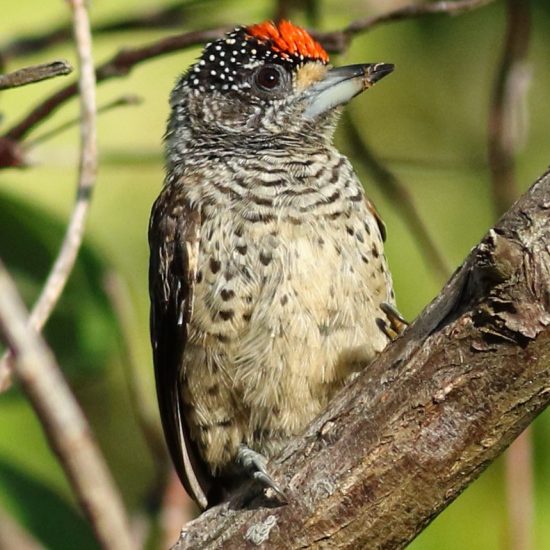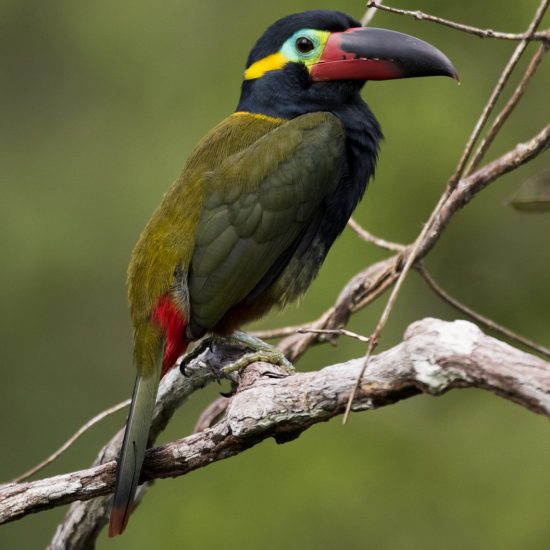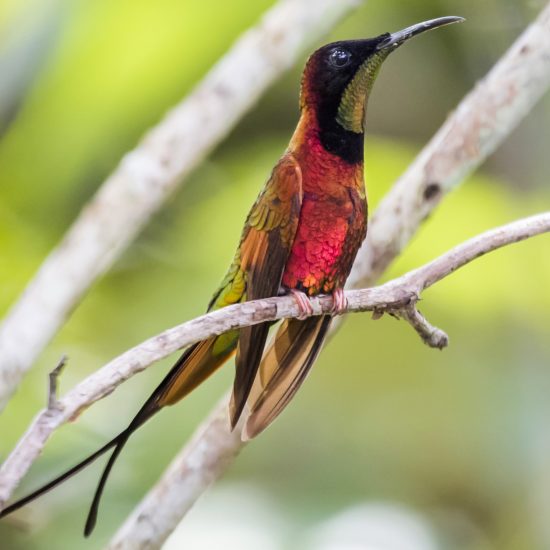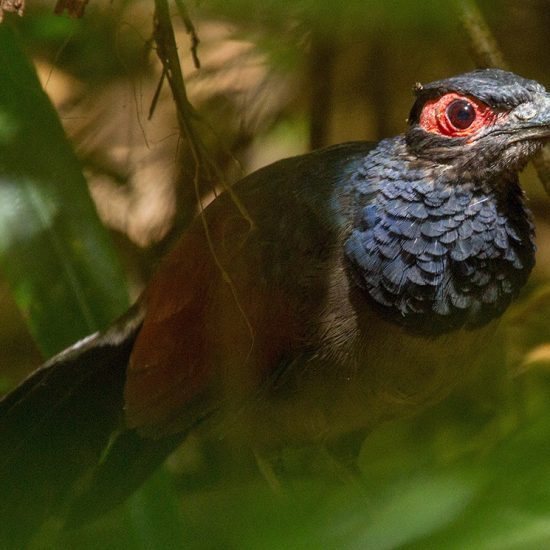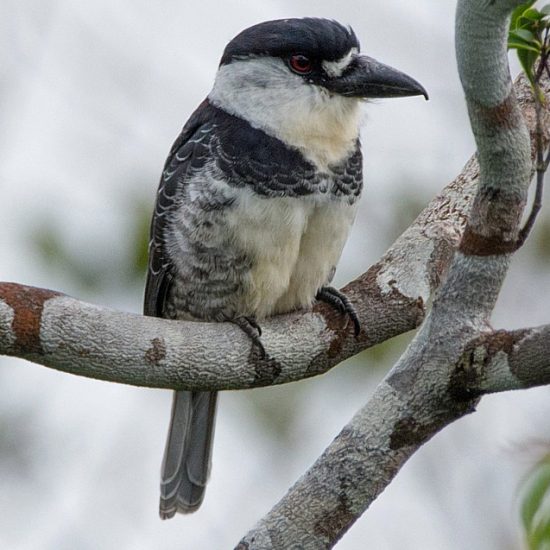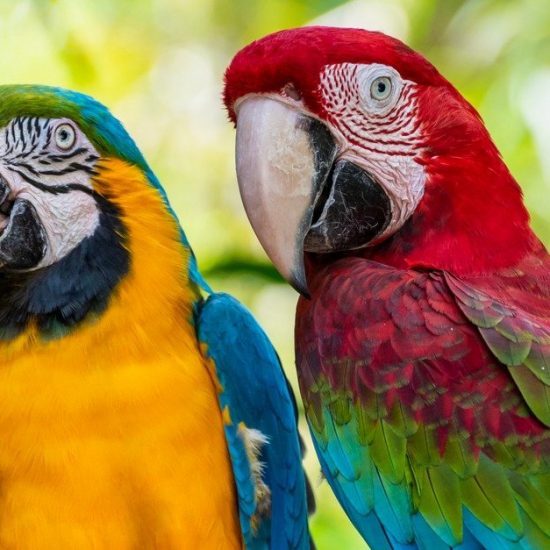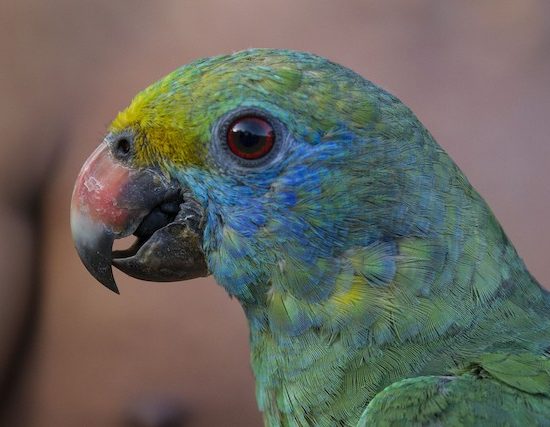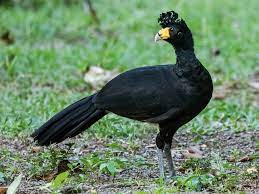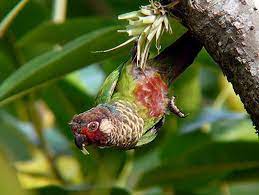Guyana’s Birding Highlights
$3995 per person
Guyana is home to more than 800 species of birds and is recognized as one of the Worlds’ top Birding Destination. Guyana’s Birding Highlights, features habitats of the Rufous Crab-Hawk, Grey-winged Trumpeter, Painted Parakeet, White-winged Potoo, Blood-coloured Woodpecker, White-bellied Piculet, Guianan Puffbird, Guianan Toucanet, Guianan Streaked-antwren, Guianan Warbling-antbird, Guianan Gnatcatcher, Guianan Red-cotinga, Crimson Fruitcrow, Capuchinbird, Guianan Cock-of-the-Rock, Blue-cheeked Amazon, Harpy Eagle, Aplomado Falcon, Crested Bobwhite, Rufous-winged Ground-cuckoo, Black Curassow, Crimson Topaz, Jabiru & Maguri Stork, Finsch’s Euphonia, Anpittas, Antrushes,Toucans, Macaws, Parrots, Hummingbirds, Sun Parakeets and many more. Other sightings include the Jaguar, Giant Anteater, Giant Otter, Black Caiman, Arapaima and numerous species of Primates, no less than the Red Howler. Tour could be customized to include specialized habitats of the Red Siskin and more sought after species on your list.
Download and print -:- Guyana’s Birding Highlights Itinerary.
Minimum Group Size -:- 2 Persons.
Included:
-
- Arrival and departure transfers
- Domestic flights
- All accommodation
- Services of English speaking guides – please note that you will have a different guide in each place on the itinerary, rather than the same guide throughout the trip
- Meals as listed (B – Breakfast, L – Lunch, D – Dinner)
- Entrance fees for sites listed as part of the itinerary
- Baggage weight allowance 50 lbs
Excluded:
-
- International flights
- Any airport taxes
- Travel Insurance
- Visas
- Drinks
Day 1: Arrival Guyana
Day 2: Georgetown, Botanical Gardens & Coastal Guyana
This morning we visit the Botanical Gardens, located in  the City of Georgetown, home to nearly two hundred bird species. After, experience Guyana’s Historic Landmarks, Colonial Architecture dating back to the Seventeenth Century, and its pluralistic, ethnically, racially and religiously diverse peoples, referred to as the “Melting Pot” of the Caribbean. Enjoy some local cuisine at Backyard Café. After lunch, drive along the Atlantic Coastline where hundreds of Scarlet Ibis, Egrets and other Sea Birds feed on the marshy flat lands. Thereafter, take boat trip up the Mahaica River to see our national bird, the Hoatzin and Rufous Crab Hawk. Overnight Cara Lodge or Similar (BL).
the City of Georgetown, home to nearly two hundred bird species. After, experience Guyana’s Historic Landmarks, Colonial Architecture dating back to the Seventeenth Century, and its pluralistic, ethnically, racially and religiously diverse peoples, referred to as the “Melting Pot” of the Caribbean. Enjoy some local cuisine at Backyard Café. After lunch, drive along the Atlantic Coastline where hundreds of Scarlet Ibis, Egrets and other Sea Birds feed on the marshy flat lands. Thereafter, take boat trip up the Mahaica River to see our national bird, the Hoatzin and Rufous Crab Hawk. Overnight Cara Lodge or Similar (BL).
Day 3: Kaieteur Falls, Home to the Guianan Cock-of the Rock
A short drive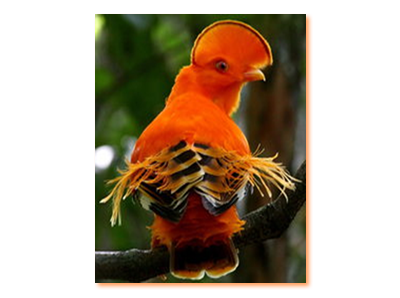 to the EF Correia International Airport for a one hour flight across Guyana’s pristine rainforest to Kaieteur Falls (World’s Largest Single Drop Water Falls). Kaieteur is nearly five times the height of Niagara Falls. Here we hope to find White-chinned and White-tipped Swifts swirling over the gorge, and the astonishingly colorful Guianan Cock-of-the-Rock. Return to Ogle Airport by aircraft at 17.00 hrs and transfer to Georgetown: Overnight Cara Lodge or Similar (BL).
to the EF Correia International Airport for a one hour flight across Guyana’s pristine rainforest to Kaieteur Falls (World’s Largest Single Drop Water Falls). Kaieteur is nearly five times the height of Niagara Falls. Here we hope to find White-chinned and White-tipped Swifts swirling over the gorge, and the astonishingly colorful Guianan Cock-of-the-Rock. Return to Ogle Airport by aircraft at 17.00 hrs and transfer to Georgetown: Overnight Cara Lodge or Similar (BL).
Day 4: Karanambu Lodge:
From the 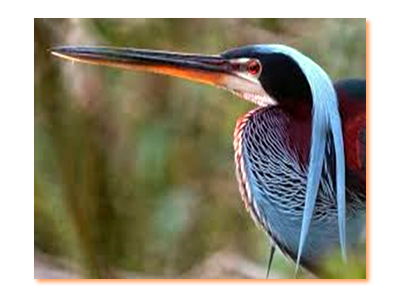 EF Correia International Airport, fly across Guyana’s Rainforest and Savannahs onto Lethem on theGuyana/Brazil Border. Continue by vehicle thru the Rupununi Savannahs, where a myriad of avian fauna feed in the flooded Savannahs, no less than the Jabiru Stork, onto Karanambu Lodge, home of the late Diane McTurk, widely known for her work in rehabilitating orphaned, giant river otters. Diane and her otters have appeared on National Geographic, Jeff Corwin Experience, Really Wild Show (BBC) and the Calgary’s “Zoo World”. Karanambu has a long history of visiting naturalists and Diane’s father, Tiny McTurk, has welcomed David Attenborough and Gerald Durrell (Three Singles to Adventure). Late in the afternoon we will travel by boat, birding along the Rupununi River, whilst on the lookout for wild Giant River Otters, etc. As dusk falls, see the giant Amazonica Waterlily, bloom. On the return trip we will spotlight for Black Caiman and birds and creatures of the night. Overnight at Karanambu Lodge (BLD).
EF Correia International Airport, fly across Guyana’s Rainforest and Savannahs onto Lethem on theGuyana/Brazil Border. Continue by vehicle thru the Rupununi Savannahs, where a myriad of avian fauna feed in the flooded Savannahs, no less than the Jabiru Stork, onto Karanambu Lodge, home of the late Diane McTurk, widely known for her work in rehabilitating orphaned, giant river otters. Diane and her otters have appeared on National Geographic, Jeff Corwin Experience, Really Wild Show (BBC) and the Calgary’s “Zoo World”. Karanambu has a long history of visiting naturalists and Diane’s father, Tiny McTurk, has welcomed David Attenborough and Gerald Durrell (Three Singles to Adventure). Late in the afternoon we will travel by boat, birding along the Rupununi River, whilst on the lookout for wild Giant River Otters, etc. As dusk falls, see the giant Amazonica Waterlily, bloom. On the return trip we will spotlight for Black Caiman and birds and creatures of the night. Overnight at Karanambu Lodge (BLD).
Day 5: Karanambu Lodge
This morning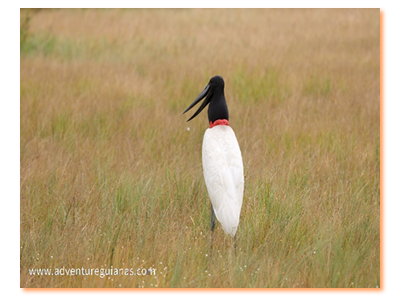 travel out to the savannah to search for a Giant Anteater, and other wildlife around the environs of the Lodge, we can bird watch around the environs of the Lodge before exploring the woodland patches or gallery forest along the river where we’ll hope to find such species as Spotted Puffbird, Striped Woodcreeper, Pale-bellied Tyrant-Manakin, Golden-spangled Piculet, Bearded Tachuri and Capuchinbird. A feature bird for the area is Agami Heron. Overnight at Karanambu Lodge (BLD).
travel out to the savannah to search for a Giant Anteater, and other wildlife around the environs of the Lodge, we can bird watch around the environs of the Lodge before exploring the woodland patches or gallery forest along the river where we’ll hope to find such species as Spotted Puffbird, Striped Woodcreeper, Pale-bellied Tyrant-Manakin, Golden-spangled Piculet, Bearded Tachuri and Capuchinbird. A feature bird for the area is Agami Heron. Overnight at Karanambu Lodge (BLD).
Day 6: Karasabai & Surama Amerindian Village:
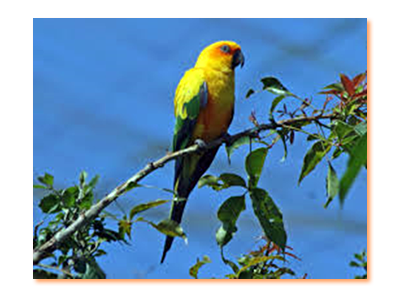 Depart early by vehicle for Karasabai Amerindian Village. The village borders with Brazil and is surrounded by the picturesque foothills of the North Pakaraima Mountains, home to the beautiful Sun Parakeet. On the way, the Crested Doradito can be found hiding in the wetlands. Continue to along the foothills of the Pakaraima to Surama Amerindian Village. The village of Surama is situated in a small savannah, deep in the rainforest and surrounded by forest clad hills. It was here that Charles Waterton passed through in 1812 in search of the secrets of the useful Wourali poison known as Curare. Waterton was so stunned by this spot that he wrote in his memoirs “The finest park that England boasts falls short of this delightful scene”. Surama’s inhabitants are mainly from the Macushi tribe and still observe many of the traditional practices of their forebears. On our arrival, we will receive a warm welcome from the local people and will be shown to our basic accommodation. Your guide will take you on a tour of the village. Visit the local school, medical centre and church along with some of the village houses. As the afternoon cools a local guide will escort you for a short walk on trails to observe the forest and bird life. See the forest through the eyes of your indigenous guide and learn about the medicinal plants and their uses in the Amerindian culture. Tonight enjoy an educational walk to observe wildlife and experience the mystique of the forest after dark. Overnight at Surama Eco-Lodge. (BLD).
Depart early by vehicle for Karasabai Amerindian Village. The village borders with Brazil and is surrounded by the picturesque foothills of the North Pakaraima Mountains, home to the beautiful Sun Parakeet. On the way, the Crested Doradito can be found hiding in the wetlands. Continue to along the foothills of the Pakaraima to Surama Amerindian Village. The village of Surama is situated in a small savannah, deep in the rainforest and surrounded by forest clad hills. It was here that Charles Waterton passed through in 1812 in search of the secrets of the useful Wourali poison known as Curare. Waterton was so stunned by this spot that he wrote in his memoirs “The finest park that England boasts falls short of this delightful scene”. Surama’s inhabitants are mainly from the Macushi tribe and still observe many of the traditional practices of their forebears. On our arrival, we will receive a warm welcome from the local people and will be shown to our basic accommodation. Your guide will take you on a tour of the village. Visit the local school, medical centre and church along with some of the village houses. As the afternoon cools a local guide will escort you for a short walk on trails to observe the forest and bird life. See the forest through the eyes of your indigenous guide and learn about the medicinal plants and their uses in the Amerindian culture. Tonight enjoy an educational walk to observe wildlife and experience the mystique of the forest after dark. Overnight at Surama Eco-Lodge. (BLD).
Day 7: Burro Burro River Tour
Rise before dawn and then take a three 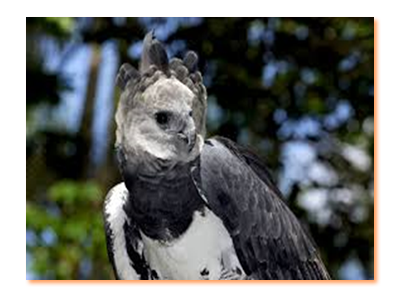 mile walk across the savannah and through the rainforest to the Burro Burro River. This is the best time to observe bird life along the trail. Your guides will then paddle you on the Burro Burro River for opportunities to observe lots of bird species, such as Red-legged Tinamou, Painted Parakeet, Dusky Parrot, Lilac-tailed Parrotlet, Pale-throated Barbthroat, Rufous-throated Sapphire, Guianan Puffbird, Northern Slaty-antshrike, Rufous-bellied Antwren, White-browed, White-bellied & Ferruginous-backed Antbirds, Lemon-chested & Ashy-headed Greenlets and Finsch’s Euphonia, Great and Paradise Jacamars, Black-spotted Barbet, Golden-spangled Piculet, Chestnut-rumped Woodcreeper, Spot-tailed and Todd’s Antwrens. Wildlife includes, Giant River Otters, Tapir, Tira, Spider Monkeys and many more species. Breakfast will be served on the river bank amidst sounds of the rainforest. Return to village for lunch. This afternoon, we would do a bit of birding around the Lodge and nearby forested galleries hoping to see Rufous-throated and Guianan Warbling Antbirds, Helmeted Pygmy-Tyrant and more: Overnight at Surama Eco Lodge (BLD).
mile walk across the savannah and through the rainforest to the Burro Burro River. This is the best time to observe bird life along the trail. Your guides will then paddle you on the Burro Burro River for opportunities to observe lots of bird species, such as Red-legged Tinamou, Painted Parakeet, Dusky Parrot, Lilac-tailed Parrotlet, Pale-throated Barbthroat, Rufous-throated Sapphire, Guianan Puffbird, Northern Slaty-antshrike, Rufous-bellied Antwren, White-browed, White-bellied & Ferruginous-backed Antbirds, Lemon-chested & Ashy-headed Greenlets and Finsch’s Euphonia, Great and Paradise Jacamars, Black-spotted Barbet, Golden-spangled Piculet, Chestnut-rumped Woodcreeper, Spot-tailed and Todd’s Antwrens. Wildlife includes, Giant River Otters, Tapir, Tira, Spider Monkeys and many more species. Breakfast will be served on the river bank amidst sounds of the rainforest. Return to village for lunch. This afternoon, we would do a bit of birding around the Lodge and nearby forested galleries hoping to see Rufous-throated and Guianan Warbling Antbirds, Helmeted Pygmy-Tyrant and more: Overnight at Surama Eco Lodge (BLD).
Day 8: Atta Rainforest Lodge & Canopy Walkway
After  breakfast we continue by vehicle to a trail in the Iwokrama Forest to see the amazingly brilliant Guianian Cock-of-the-rock and even the elusive Jaguar. The Iwokrama forest is rapidly gaining an international reputation for its healthy jaguar populations that seem not to be troubled by the appearance of curious humans. No promises, but many have been lucky! Along the road, we will watch for the myriad of bird species that frequent the forest edge, including Crimson and Purple-necked Fruit-crow, Crimson Topaz, Green Oropendula, Spotted and Guianan Puffbird, Scarlet and Red-and-Green Macaw, Blue-cheeked and Orange-winged Parrot and Gray-winged Trumpeter. The journey concludes at the Iwokrama Canopy Walkway where we can bird watch from the vantage of 30 Metres up in the canopy. Painted Parakeet, Rufous-throated Sapphire, Guianan Puffbird, Green Aracari, Waved Woodpecker, Pygmy Antwren, Guianan Streaked-Antwren, Dusky Purpletuft, Purple-breasted Cotinga, Guianan Toucanet, Pompadour Cotinga, Buff-cheeked Greenlet, Caica Parrots, and a host of crown specialists may come within our view. From this tree top vantage you can sometimes see Red Howler Monkeys and Black Spider Monkeys. The trails also have an interpretative walk with the trees named and you can learn about their varied uses in the Macushi culture. Deer and agouti are also regular visitors to the lodge. As dark falls on the Canopy Walkway, we will hope to see the White-winged Potoo. Overnight at Atta Rainforest Lodge (BLD).
breakfast we continue by vehicle to a trail in the Iwokrama Forest to see the amazingly brilliant Guianian Cock-of-the-rock and even the elusive Jaguar. The Iwokrama forest is rapidly gaining an international reputation for its healthy jaguar populations that seem not to be troubled by the appearance of curious humans. No promises, but many have been lucky! Along the road, we will watch for the myriad of bird species that frequent the forest edge, including Crimson and Purple-necked Fruit-crow, Crimson Topaz, Green Oropendula, Spotted and Guianan Puffbird, Scarlet and Red-and-Green Macaw, Blue-cheeked and Orange-winged Parrot and Gray-winged Trumpeter. The journey concludes at the Iwokrama Canopy Walkway where we can bird watch from the vantage of 30 Metres up in the canopy. Painted Parakeet, Rufous-throated Sapphire, Guianan Puffbird, Green Aracari, Waved Woodpecker, Pygmy Antwren, Guianan Streaked-Antwren, Dusky Purpletuft, Purple-breasted Cotinga, Guianan Toucanet, Pompadour Cotinga, Buff-cheeked Greenlet, Caica Parrots, and a host of crown specialists may come within our view. From this tree top vantage you can sometimes see Red Howler Monkeys and Black Spider Monkeys. The trails also have an interpretative walk with the trees named and you can learn about their varied uses in the Macushi culture. Deer and agouti are also regular visitors to the lodge. As dark falls on the Canopy Walkway, we will hope to see the White-winged Potoo. Overnight at Atta Rainforest Lodge (BLD).
Day 9: Atta Rainforest Lodge & Canopy Walkway
Although 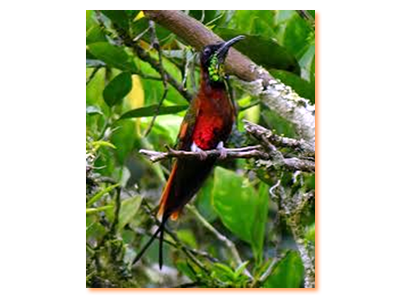 the forest around Atta Lodge is excellent for birds, the major attraction here is a 154 metre long canopy walkway which is only 750m from the lodge. The walkway has four platforms, the highest of which is over 30 metres above the ground, and these will allow us to get great looks at a range of canopy species, many of which we would struggle to see well from the forest floor. Amongst the likely highlights are Painted, Brown-throated and Golden-winged Parakeets, Caica Parrot, Guianan Puffbird, Waved and Golden-collared Woodpeckers and Spot-tailed, Todd’s and Ash-winged Antwrens. The walkway is also an excellent place to look for various species of cotinga including the poorly known and range-restricted Dusky Purpletuft and if there are any suitable fruiting trees nearby, we stand a good chance of seeing this bird, as well as the more widespread Purple-breasted Cotinga. Another area where we will want to spend some time is the clearing around the lodge, as this is one of the best places to see another of Guyana’s “must see” birds, the Crimson Fruitcrow. This species is seen here on a reasonably regular basis, as it often comes to feed in some of the nearby trees. The clearing is also a reliable site for Black Curassow as there is a family party which has become habituated to people and regularly passes through the clearing. With reasonable luck, we should be able to add this bird to the impressive list of species we hope to see around the lodge and walkway. The unusually timid Black Curassow can also be seen as at least one family party has become habituated and regularly feeds in the clearing of Atta Rainforest Lodge. After lunch we venture out onto the main road to nearby shrubs to do some more birding. Traffic is only very occasional and wildlife is often seen along the road, such as Agouti, Tayra, Puma, Tapir and Black Curassow. Overnight Atta Rainforest Lodge (BLD).
the forest around Atta Lodge is excellent for birds, the major attraction here is a 154 metre long canopy walkway which is only 750m from the lodge. The walkway has four platforms, the highest of which is over 30 metres above the ground, and these will allow us to get great looks at a range of canopy species, many of which we would struggle to see well from the forest floor. Amongst the likely highlights are Painted, Brown-throated and Golden-winged Parakeets, Caica Parrot, Guianan Puffbird, Waved and Golden-collared Woodpeckers and Spot-tailed, Todd’s and Ash-winged Antwrens. The walkway is also an excellent place to look for various species of cotinga including the poorly known and range-restricted Dusky Purpletuft and if there are any suitable fruiting trees nearby, we stand a good chance of seeing this bird, as well as the more widespread Purple-breasted Cotinga. Another area where we will want to spend some time is the clearing around the lodge, as this is one of the best places to see another of Guyana’s “must see” birds, the Crimson Fruitcrow. This species is seen here on a reasonably regular basis, as it often comes to feed in some of the nearby trees. The clearing is also a reliable site for Black Curassow as there is a family party which has become habituated to people and regularly passes through the clearing. With reasonable luck, we should be able to add this bird to the impressive list of species we hope to see around the lodge and walkway. The unusually timid Black Curassow can also be seen as at least one family party has become habituated and regularly feeds in the clearing of Atta Rainforest Lodge. After lunch we venture out onto the main road to nearby shrubs to do some more birding. Traffic is only very occasional and wildlife is often seen along the road, such as Agouti, Tayra, Puma, Tapir and Black Curassow. Overnight Atta Rainforest Lodge (BLD).
Day 10: Aircraft Transfer to Georgetown
Vehicle transfer to either Iwokrama or Lethem Airstrip for flight to EF Correia International Airport where our personnel will take you to your Hotel in Georgetown: Overnight Cara Lodge or Similar (B).
